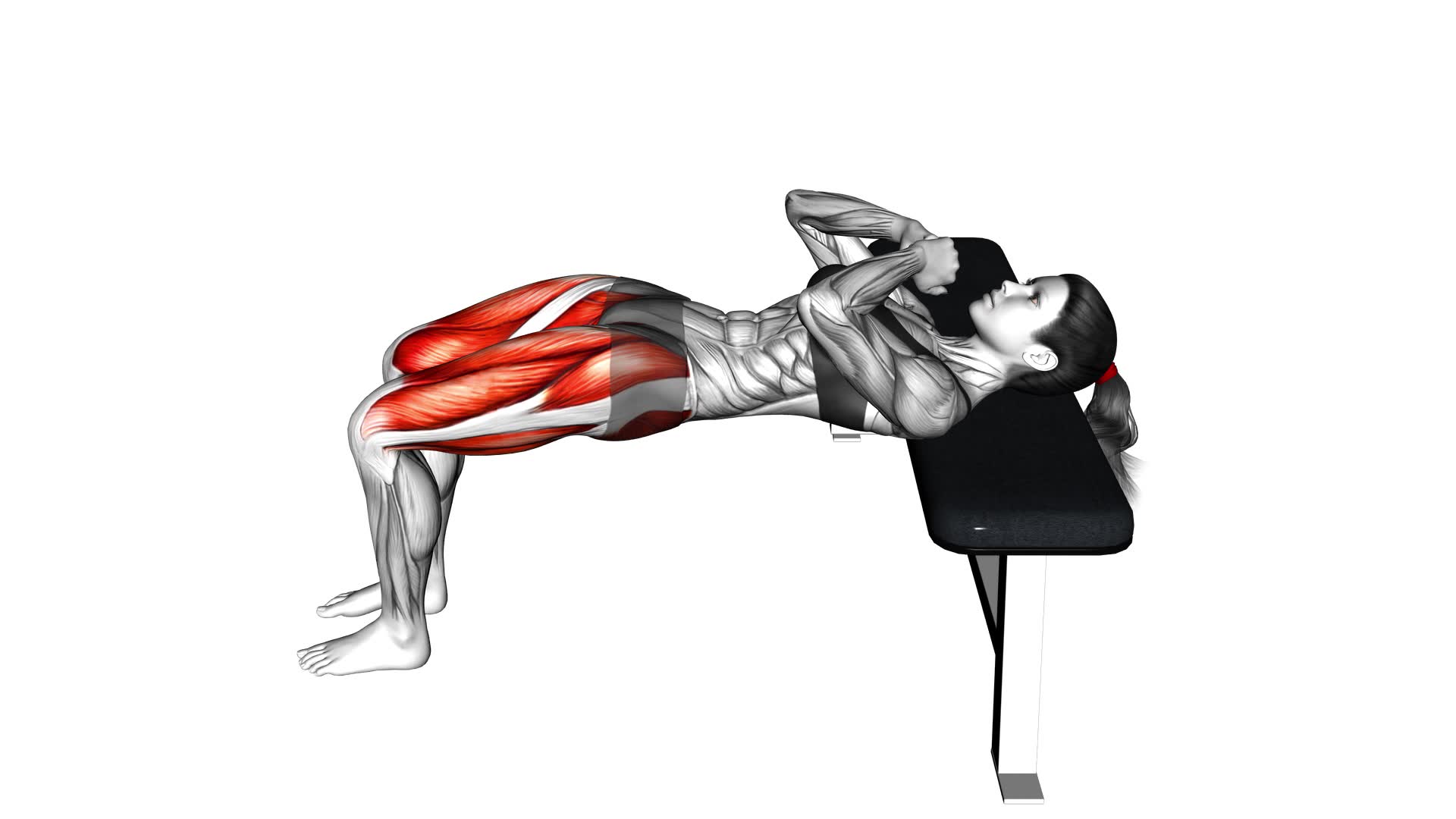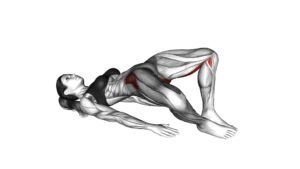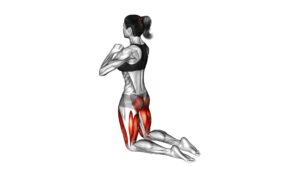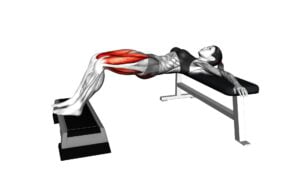Hip Thrust Side Step (female) – Video Exercise Guide & Tips

Looking for a new exercise to target your glutes and improve your lower body strength? Check out the Hip Thrust Side Step!
Watch This Exercise Video
This video exercise guide and tips will show you the proper technique and form to execute this move effectively. With variations for all fitness levels, you can easily modify the exercise to suit your needs.
Avoid common mistakes and maximize your results with these helpful tips.
Let's get started!
Key Takeaways
- The hip thrust side step engages multiple muscle groups simultaneously and improves stability.
- It specifically targets the glute muscles, including the gluteus maximus, gluteus medius, and gluteus minimus.
- The exercise helps with hip extension, walking, running, and climbing stairs.
- Proper technique and form, such as engaging the glutes and core and maintaining a straight line from shoulders to knees, are important for maximizing effectiveness and preventing injury.
Benefits of the Hip Thrust Side Step
To fully understand the benefits of the Hip Thrust Side Step, it's important to recognize that this exercise engages multiple muscle groups simultaneously. One of the key benefits of this exercise is that it helps improve stability. By combining hip thrusts with side steps, you're challenging your body to maintain balance and control throughout the movement. This can be particularly beneficial for individuals who struggle with balance or have weak stabilizer muscles.
Another major benefit of the Hip Thrust Side Step is its ability to target the glute muscles. The hip thrust component of the exercise primarily activates the gluteus maximus, the largest muscle in the buttocks. This muscle is responsible for hip extension and plays a crucial role in activities such as walking, running, and climbing stairs. By adding the side step, you also engage the gluteus medius and minimus, which are important for hip abduction and stability.
Proper Technique and Form
Perform the Hip Thrust Side Step with proper technique and form to maximize the effectiveness of the exercise.
When executing this movement, it's important to focus on the benefits of activation and muscle engagement.
To begin, position yourself on the ground with your back against a bench or step, knees bent, and feet flat on the floor. Place a resistance band just above your knees to add resistance to the exercise.
Engage your glutes and core, then lift your hips off the ground, creating a straight line from your shoulders to your knees.
Next, take a step to the side with one foot, maintaining tension in the resistance band throughout the movement. Keep your hips lifted and avoid any side-to-side tilting.
Return to the starting position by bringing your feet together, then repeat the movement to the other side.
Remember to maintain proper form throughout the exercise by keeping your core engaged and your hips elevated.
Variations and Modifications for All Fitness Levels
Once you have mastered the proper technique and form for the Hip Thrust Side Step, you can explore variations and modifications to accommodate different fitness levels.
Here are some progression options and equipment recommendations to help you continue challenging yourself and making progress:
Progression Options:
- Increase resistance: Once you feel comfortable with the movement, you can add resistance by using a resistance band or holding a dumbbell or kettlebell on your hips. This will increase the intensity and workload on your glutes and hips.
- Increase range of motion: You can make the exercise more challenging by increasing the range of motion. Instead of stepping out to the side, you can step diagonally or step onto an elevated platform. This will engage your muscles in a different way and provide a greater challenge.
Equipment Recommendations:
- Resistance band: A resistance band is a versatile and affordable piece of equipment that can be used to add resistance to the Hip Thrust Side Step. It's lightweight and portable, making it convenient for home workouts or when you're on the go.
- Dumbbell or kettlebell: Holding a dumbbell or kettlebell on your hips will add extra weight and resistance to the exercise, helping to build strength and muscle in your glutes and hips.
Common Mistakes to Avoid
When performing the Hip Thrust Side Step, it's important to be aware of common mistakes that you should avoid to ensure proper form and maximize the effectiveness of the exercise.
One common mistake is using too much momentum instead of engaging your glutes and core muscles. Remember to focus on the contraction of your glutes as you perform each movement, rather than relying on momentum to swing your leg out to the side.
Another mistake to avoid is allowing your knees to collapse inward during the side step. This can put stress on your knees and compromise the effectiveness of the exercise. To prevent this, make sure to keep your knees in line with your toes throughout the movement.
Lastly, it's important to maintain a neutral spine throughout the exercise. Avoid arching your lower back or rounding your upper back, as these can lead to poor form and potential injury.
By avoiding these common mistakes and practicing proper technique, you can ensure that you're getting the most out of your Hip Thrust Side Step exercise.
In the next section, we'll provide you with some tips for maximizing your results.
Tips for Maximizing Results
To maximize your results, focus on engaging your glutes and core muscles throughout the Hip Thrust Side Step exercise. This will help you maximize the intensity of the workout and ensure that you're targeting the right muscles.
Here are some tips to help you get the most out of this exercise:
- Incorporate resistance: To increase the intensity of the exercise, consider using resistance bands or a weight plate. This will add an extra challenge for your glutes and core muscles, helping you build strength and tone.
- Maintain good form: It's important to maintain proper form throughout the exercise to maximize its effectiveness. Keep your back straight, engage your core, and avoid leaning forward or backward. This will ensure that you're targeting the right muscles and reduce the risk of injury.
- Focus on controlled movements: Instead of rushing through the exercise, focus on performing slow and controlled movements. This will engage your muscles more effectively and maximize the benefits of the exercise.
- Increase the number of repetitions or sets: As you become more comfortable with the exercise, consider increasing the number of repetitions or sets. This will help increase the intensity and challenge your muscles even more.
Frequently Asked Questions
How Many Calories Can You Burn by Performing the Hip Thrust Side Step?
You can burn a significant amount of calories by performing the hip thrust side step. This exercise engages multiple muscle groups, including the glutes, hamstrings, and core, which helps increase your overall calorie burn.
The hip thrust side step also improves hip mobility, strengthens the lower body, and enhances stability. Incorporating this exercise into your fitness routine can contribute to weight loss and overall fitness goals.
Can the Hip Thrust Side Step Help Improve Balance and Stability?
The hip thrust side step can indeed help improve your balance and stability. By incorporating this exercise into your routine, you can enhance your coordination and strengthen your glutes.
It targets the muscles in your hips and buttocks, which are crucial for maintaining stability and balance. Regularly performing the hip thrust side step can provide you with the necessary strength and control to stay steady on your feet during various activities and movements.
What Muscles Are Targeted During the Hip Thrust Side Step?
The hip thrust side step targets several key muscles in your lower body. It primarily activates your glutes, helping to strengthen and tone them. This exercise also engages your quadriceps, hamstrings, and hip abductors.
Is It Necessary to Use a Resistance Band While Performing the Hip Thrust Side Step?
Using a resistance band during the hip thrust side step isn't necessary, but it can provide additional benefits. The resistance band adds extra resistance, making the exercise more challenging and helping to strengthen your glutes and hips.
It can also improve your balance and stability. Incorporating a resistance band into your workout routine can enhance your weightlifting benefits and help you achieve your fitness goals.
Can the Hip Thrust Side Step Be Incorporated Into a Full-Body Workout Routine?
Yes, you can definitely incorporate the hip thrust side step into your full-body workout routine. It's a great exercise for targeting your glutes and can be done as part of a cardio routine.
The hip thrust side step helps to strengthen and tone your glute muscles, improving overall lower body strength and stability.
It also adds variety to your workout, making it more enjoyable and challenging.
Conclusion
In conclusion, the hip thrust side step is a highly effective exercise for strengthening the hips and glutes. By maintaining proper technique and form, individuals of all fitness levels can benefit from this exercise.
It's important to avoid common mistakes and follow the provided tips for maximizing results. Incorporating the hip thrust side step into your fitness routine can help you achieve your strength and conditioning goals.

Author
Years ago, the spark of my life’s passion ignited in my mind the moment I stepped into the local gym for the first time. The inaugural bead of perspiration, the initial endeavor, the very first surge of endorphins, and a sense of pride that washed over me post-workout marked the beginning of my deep-seated interest in strength sports, fitness, and sports nutrition. This very curiosity blossomed rapidly into a profound fascination, propelling me to earn a Master’s degree in Physical Education from the Academy of Physical Education in Krakow, followed by a Sports Manager diploma from the Jagiellonian University. My journey of growth led me to gain more specialized qualifications, such as being a certified personal trainer with a focus on sports dietetics, a lifeguard, and an instructor for wellness and corrective gymnastics. Theoretical knowledge paired seamlessly with practical experience, reinforcing my belief that the transformation of individuals under my guidance was also a reflection of my personal growth. This belief holds true even today. Each day, I strive to push the boundaries and explore new realms. These realms gently elevate me to greater heights. The unique combination of passion for my field and the continuous quest for growth fuels my drive to break new ground.







